University Case Study: HNN215 Quality Use of Medicines Analysis
VerifiedAdded on 2023/01/13
|11
|2961
|23
Case Study
AI Summary
This case study analyzes the medication regimen of Mr. Michael Coleman, a 56-year-old patient admitted with chest pain, hypertension, and ischemic heart disease. The assignment explores the risks associated with his prescribed medications, including atenolol, ramipril, enoxaparin, and atorvastatin, addressing potential adverse effects like hypotension and bleeding. It investigates the need for nursing interventions to manage these risks, including strategies for hypotension and bleeding. The case study also examines factors affecting medication adherence and provides patient education on atorvastatin, including administration, side effects, and emergency situations. The analysis emphasizes the importance of patient education, lifestyle modifications, and adherence to prescribed medications to improve patient outcomes. The assignment highlights the nurse's role in medication management and patient safety.

Running head: CASE STUDY
HNN215 Quality use of Medicines
Name of the Student
Name of the University
Author note
HNN215 Quality use of Medicines
Name of the Student
Name of the University
Author note
Paraphrase This Document
Need a fresh take? Get an instant paraphrase of this document with our AI Paraphraser

1CASE STUDY
Answer 1
Upon analysing the medication charts, it was found that Mr Coleman had been
prescribed most medicines for addressing his presenting complaints of chest pain,
hypertension, and heart failure due to angina. He had been prescribed atenolol that is
commonly known as a beta blocker and used for the management of heart associated pain in
the chest. In addition, the drug also helps in treatment of heart beat irregularities (Wiysonge,
Bradley, Volmink, Mayosi & Opie, 2017). In contrast, the medication ramipril is also
administered for the treatment of heart failure, high blood pressure, and diabetic renal disease
(Bull et al., 2015). However, both of these drugs are associated with significant adverse
effects. Hypotension was the major risk factor associated with the administration of both of
these drugs. The drugs affect the responses to the nerve impulses that are present in the heart
that makes the heart beat slower, thereby reducing the increased blood pressure. However,
under circumstances when the blood pressure gets lowered, the amount of oxygen and blood
is increased to the cardiac muscles. Nonetheless, both atenolol and ramipril might decrease
the cardiac output (CO) that commonly refers to the product of heart beats per minute and
stroke volume (Briasoulis, Silver, Yano & Bakris, 2014). In addition, the drugs might also
bring about an inhibition of the renin-angiotensin-aldosterone system. Owing to the fact that
angiotensin II plays an important role as an arteriole vasoconstrictor and also results in a
constriction in the afferent arterioles, thereby increasing arteriolar resistance, an inhibition of
the RAAS would be responsible for the onset of hypotension (Rajgopal, Rajan, Sapru & Paul,
2014). Furthermore, the risk for hypotension can also be accredited to the potassium retaining
activity of the drugs.
Mr Coleman has also been administered enoxaparin sodium that is a potent
anticoagulant and primarily prescribed for the treatment and prevention of deep vein
thrombosis (DVT). The drug binds to antithrombin with the aim of forming a complex that
Answer 1
Upon analysing the medication charts, it was found that Mr Coleman had been
prescribed most medicines for addressing his presenting complaints of chest pain,
hypertension, and heart failure due to angina. He had been prescribed atenolol that is
commonly known as a beta blocker and used for the management of heart associated pain in
the chest. In addition, the drug also helps in treatment of heart beat irregularities (Wiysonge,
Bradley, Volmink, Mayosi & Opie, 2017). In contrast, the medication ramipril is also
administered for the treatment of heart failure, high blood pressure, and diabetic renal disease
(Bull et al., 2015). However, both of these drugs are associated with significant adverse
effects. Hypotension was the major risk factor associated with the administration of both of
these drugs. The drugs affect the responses to the nerve impulses that are present in the heart
that makes the heart beat slower, thereby reducing the increased blood pressure. However,
under circumstances when the blood pressure gets lowered, the amount of oxygen and blood
is increased to the cardiac muscles. Nonetheless, both atenolol and ramipril might decrease
the cardiac output (CO) that commonly refers to the product of heart beats per minute and
stroke volume (Briasoulis, Silver, Yano & Bakris, 2014). In addition, the drugs might also
bring about an inhibition of the renin-angiotensin-aldosterone system. Owing to the fact that
angiotensin II plays an important role as an arteriole vasoconstrictor and also results in a
constriction in the afferent arterioles, thereby increasing arteriolar resistance, an inhibition of
the RAAS would be responsible for the onset of hypotension (Rajgopal, Rajan, Sapru & Paul,
2014). Furthermore, the risk for hypotension can also be accredited to the potassium retaining
activity of the drugs.
Mr Coleman has also been administered enoxaparin sodium that is a potent
anticoagulant and primarily prescribed for the treatment and prevention of deep vein
thrombosis (DVT). The drug binds to antithrombin with the aim of forming a complex that
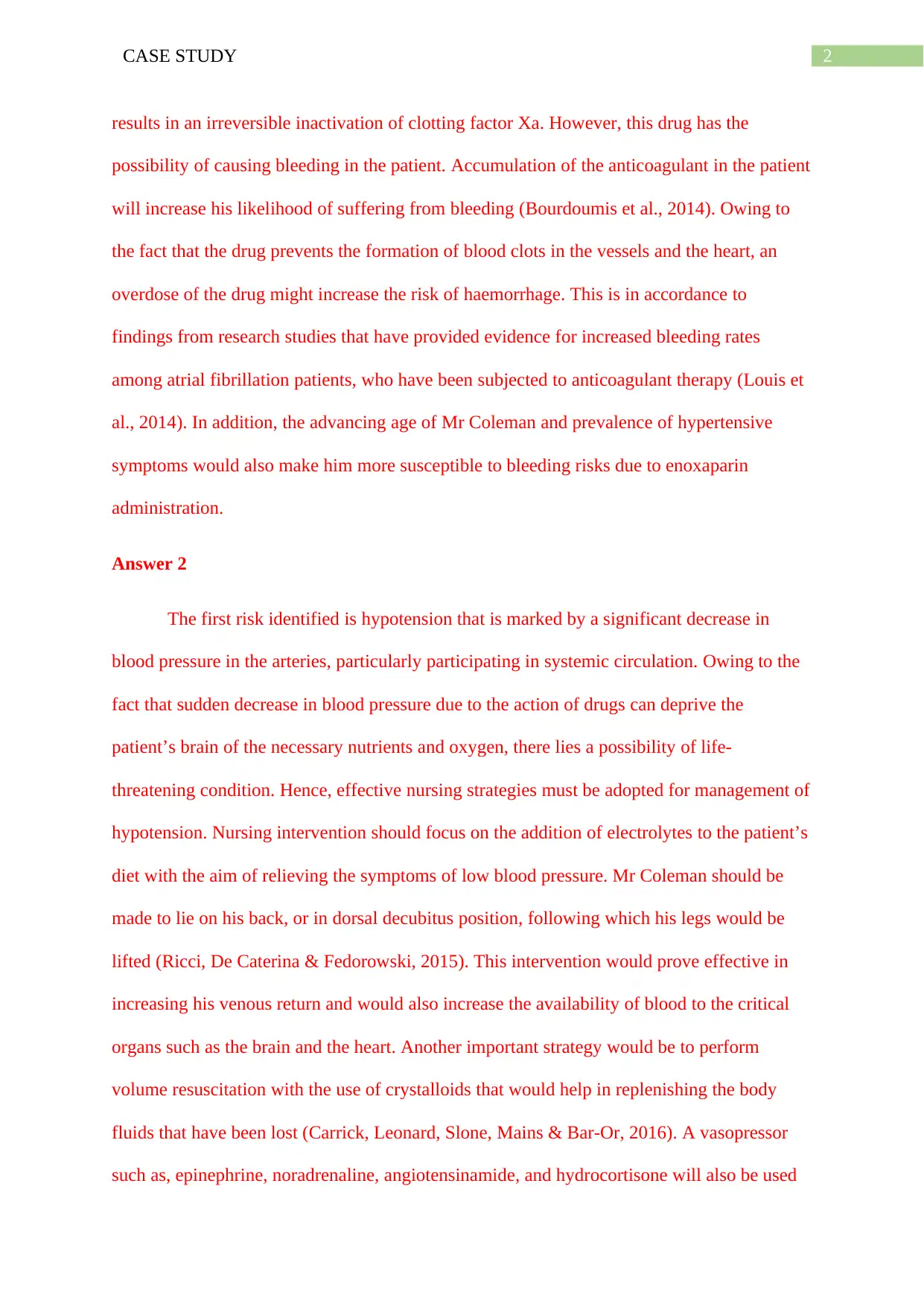
2CASE STUDY
results in an irreversible inactivation of clotting factor Xa. However, this drug has the
possibility of causing bleeding in the patient. Accumulation of the anticoagulant in the patient
will increase his likelihood of suffering from bleeding (Bourdoumis et al., 2014). Owing to
the fact that the drug prevents the formation of blood clots in the vessels and the heart, an
overdose of the drug might increase the risk of haemorrhage. This is in accordance to
findings from research studies that have provided evidence for increased bleeding rates
among atrial fibrillation patients, who have been subjected to anticoagulant therapy (Louis et
al., 2014). In addition, the advancing age of Mr Coleman and prevalence of hypertensive
symptoms would also make him more susceptible to bleeding risks due to enoxaparin
administration.
Answer 2
The first risk identified is hypotension that is marked by a significant decrease in
blood pressure in the arteries, particularly participating in systemic circulation. Owing to the
fact that sudden decrease in blood pressure due to the action of drugs can deprive the
patient’s brain of the necessary nutrients and oxygen, there lies a possibility of life-
threatening condition. Hence, effective nursing strategies must be adopted for management of
hypotension. Nursing intervention should focus on the addition of electrolytes to the patient’s
diet with the aim of relieving the symptoms of low blood pressure. Mr Coleman should be
made to lie on his back, or in dorsal decubitus position, following which his legs would be
lifted (Ricci, De Caterina & Fedorowski, 2015). This intervention would prove effective in
increasing his venous return and would also increase the availability of blood to the critical
organs such as the brain and the heart. Another important strategy would be to perform
volume resuscitation with the use of crystalloids that would help in replenishing the body
fluids that have been lost (Carrick, Leonard, Slone, Mains & Bar-Or, 2016). A vasopressor
such as, epinephrine, noradrenaline, angiotensinamide, and hydrocortisone will also be used
results in an irreversible inactivation of clotting factor Xa. However, this drug has the
possibility of causing bleeding in the patient. Accumulation of the anticoagulant in the patient
will increase his likelihood of suffering from bleeding (Bourdoumis et al., 2014). Owing to
the fact that the drug prevents the formation of blood clots in the vessels and the heart, an
overdose of the drug might increase the risk of haemorrhage. This is in accordance to
findings from research studies that have provided evidence for increased bleeding rates
among atrial fibrillation patients, who have been subjected to anticoagulant therapy (Louis et
al., 2014). In addition, the advancing age of Mr Coleman and prevalence of hypertensive
symptoms would also make him more susceptible to bleeding risks due to enoxaparin
administration.
Answer 2
The first risk identified is hypotension that is marked by a significant decrease in
blood pressure in the arteries, particularly participating in systemic circulation. Owing to the
fact that sudden decrease in blood pressure due to the action of drugs can deprive the
patient’s brain of the necessary nutrients and oxygen, there lies a possibility of life-
threatening condition. Hence, effective nursing strategies must be adopted for management of
hypotension. Nursing intervention should focus on the addition of electrolytes to the patient’s
diet with the aim of relieving the symptoms of low blood pressure. Mr Coleman should be
made to lie on his back, or in dorsal decubitus position, following which his legs would be
lifted (Ricci, De Caterina & Fedorowski, 2015). This intervention would prove effective in
increasing his venous return and would also increase the availability of blood to the critical
organs such as the brain and the heart. Another important strategy would be to perform
volume resuscitation with the use of crystalloids that would help in replenishing the body
fluids that have been lost (Carrick, Leonard, Slone, Mains & Bar-Or, 2016). A vasopressor
such as, epinephrine, noradrenaline, angiotensinamide, and hydrocortisone will also be used
⊘ This is a preview!⊘
Do you want full access?
Subscribe today to unlock all pages.

Trusted by 1+ million students worldwide
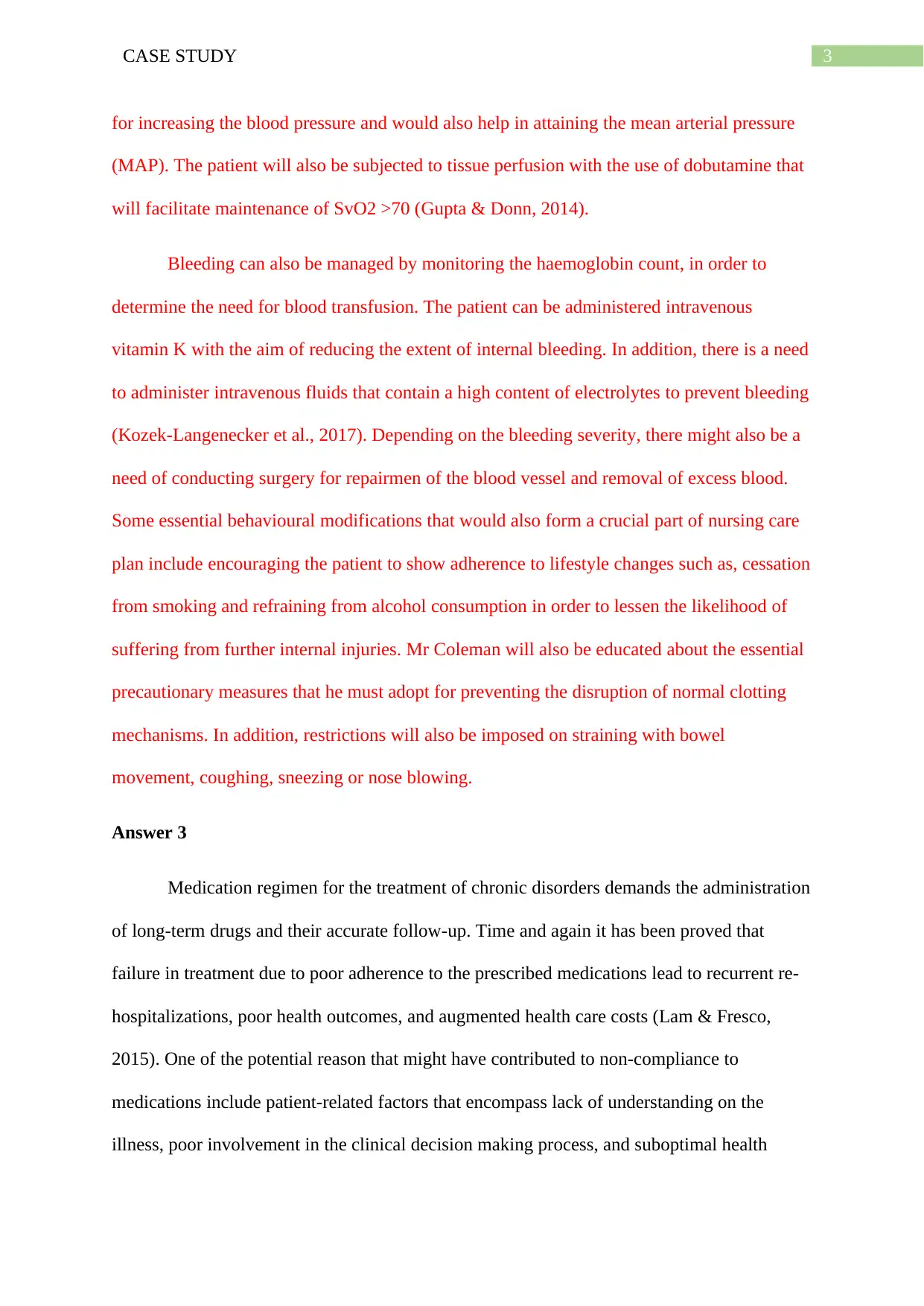
3CASE STUDY
for increasing the blood pressure and would also help in attaining the mean arterial pressure
(MAP). The patient will also be subjected to tissue perfusion with the use of dobutamine that
will facilitate maintenance of SvO2 >70 (Gupta & Donn, 2014).
Bleeding can also be managed by monitoring the haemoglobin count, in order to
determine the need for blood transfusion. The patient can be administered intravenous
vitamin K with the aim of reducing the extent of internal bleeding. In addition, there is a need
to administer intravenous fluids that contain a high content of electrolytes to prevent bleeding
(Kozek-Langenecker et al., 2017). Depending on the bleeding severity, there might also be a
need of conducting surgery for repairmen of the blood vessel and removal of excess blood.
Some essential behavioural modifications that would also form a crucial part of nursing care
plan include encouraging the patient to show adherence to lifestyle changes such as, cessation
from smoking and refraining from alcohol consumption in order to lessen the likelihood of
suffering from further internal injuries. Mr Coleman will also be educated about the essential
precautionary measures that he must adopt for preventing the disruption of normal clotting
mechanisms. In addition, restrictions will also be imposed on straining with bowel
movement, coughing, sneezing or nose blowing.
Answer 3
Medication regimen for the treatment of chronic disorders demands the administration
of long-term drugs and their accurate follow-up. Time and again it has been proved that
failure in treatment due to poor adherence to the prescribed medications lead to recurrent re-
hospitalizations, poor health outcomes, and augmented health care costs (Lam & Fresco,
2015). One of the potential reason that might have contributed to non-compliance to
medications include patient-related factors that encompass lack of understanding on the
illness, poor involvement in the clinical decision making process, and suboptimal health
for increasing the blood pressure and would also help in attaining the mean arterial pressure
(MAP). The patient will also be subjected to tissue perfusion with the use of dobutamine that
will facilitate maintenance of SvO2 >70 (Gupta & Donn, 2014).
Bleeding can also be managed by monitoring the haemoglobin count, in order to
determine the need for blood transfusion. The patient can be administered intravenous
vitamin K with the aim of reducing the extent of internal bleeding. In addition, there is a need
to administer intravenous fluids that contain a high content of electrolytes to prevent bleeding
(Kozek-Langenecker et al., 2017). Depending on the bleeding severity, there might also be a
need of conducting surgery for repairmen of the blood vessel and removal of excess blood.
Some essential behavioural modifications that would also form a crucial part of nursing care
plan include encouraging the patient to show adherence to lifestyle changes such as, cessation
from smoking and refraining from alcohol consumption in order to lessen the likelihood of
suffering from further internal injuries. Mr Coleman will also be educated about the essential
precautionary measures that he must adopt for preventing the disruption of normal clotting
mechanisms. In addition, restrictions will also be imposed on straining with bowel
movement, coughing, sneezing or nose blowing.
Answer 3
Medication regimen for the treatment of chronic disorders demands the administration
of long-term drugs and their accurate follow-up. Time and again it has been proved that
failure in treatment due to poor adherence to the prescribed medications lead to recurrent re-
hospitalizations, poor health outcomes, and augmented health care costs (Lam & Fresco,
2015). One of the potential reason that might have contributed to non-compliance to
medications include patient-related factors that encompass lack of understanding on the
illness, poor involvement in the clinical decision making process, and suboptimal health
Paraphrase This Document
Need a fresh take? Get an instant paraphrase of this document with our AI Paraphraser
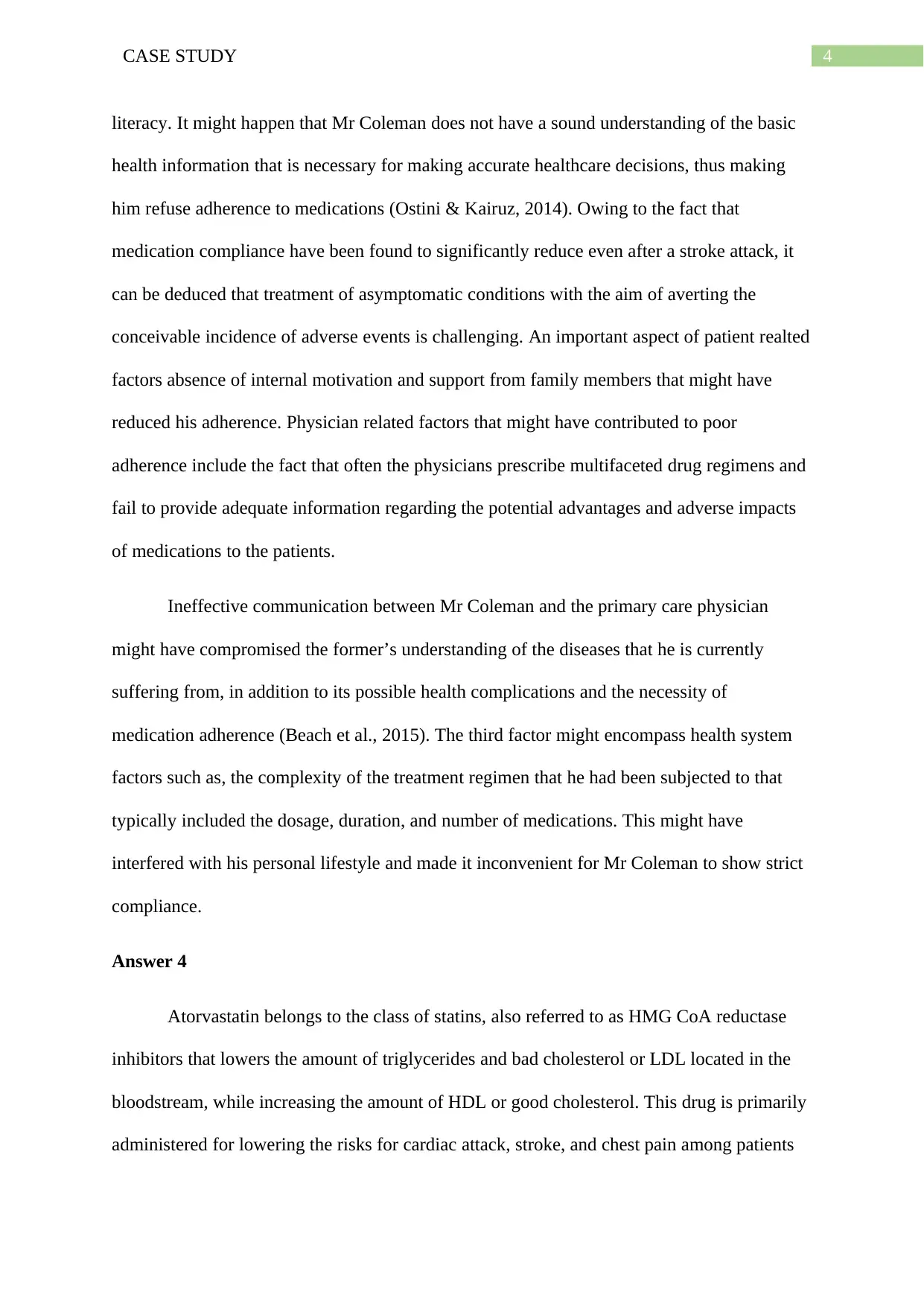
4CASE STUDY
literacy. It might happen that Mr Coleman does not have a sound understanding of the basic
health information that is necessary for making accurate healthcare decisions, thus making
him refuse adherence to medications (Ostini & Kairuz, 2014). Owing to the fact that
medication compliance have been found to significantly reduce even after a stroke attack, it
can be deduced that treatment of asymptomatic conditions with the aim of averting the
conceivable incidence of adverse events is challenging. An important aspect of patient realted
factors absence of internal motivation and support from family members that might have
reduced his adherence. Physician related factors that might have contributed to poor
adherence include the fact that often the physicians prescribe multifaceted drug regimens and
fail to provide adequate information regarding the potential advantages and adverse impacts
of medications to the patients.
Ineffective communication between Mr Coleman and the primary care physician
might have compromised the former’s understanding of the diseases that he is currently
suffering from, in addition to its possible health complications and the necessity of
medication adherence (Beach et al., 2015). The third factor might encompass health system
factors such as, the complexity of the treatment regimen that he had been subjected to that
typically included the dosage, duration, and number of medications. This might have
interfered with his personal lifestyle and made it inconvenient for Mr Coleman to show strict
compliance.
Answer 4
Atorvastatin belongs to the class of statins, also referred to as HMG CoA reductase
inhibitors that lowers the amount of triglycerides and bad cholesterol or LDL located in the
bloodstream, while increasing the amount of HDL or good cholesterol. This drug is primarily
administered for lowering the risks for cardiac attack, stroke, and chest pain among patients
literacy. It might happen that Mr Coleman does not have a sound understanding of the basic
health information that is necessary for making accurate healthcare decisions, thus making
him refuse adherence to medications (Ostini & Kairuz, 2014). Owing to the fact that
medication compliance have been found to significantly reduce even after a stroke attack, it
can be deduced that treatment of asymptomatic conditions with the aim of averting the
conceivable incidence of adverse events is challenging. An important aspect of patient realted
factors absence of internal motivation and support from family members that might have
reduced his adherence. Physician related factors that might have contributed to poor
adherence include the fact that often the physicians prescribe multifaceted drug regimens and
fail to provide adequate information regarding the potential advantages and adverse impacts
of medications to the patients.
Ineffective communication between Mr Coleman and the primary care physician
might have compromised the former’s understanding of the diseases that he is currently
suffering from, in addition to its possible health complications and the necessity of
medication adherence (Beach et al., 2015). The third factor might encompass health system
factors such as, the complexity of the treatment regimen that he had been subjected to that
typically included the dosage, duration, and number of medications. This might have
interfered with his personal lifestyle and made it inconvenient for Mr Coleman to show strict
compliance.
Answer 4
Atorvastatin belongs to the class of statins, also referred to as HMG CoA reductase
inhibitors that lowers the amount of triglycerides and bad cholesterol or LDL located in the
bloodstream, while increasing the amount of HDL or good cholesterol. This drug is primarily
administered for lowering the risks for cardiac attack, stroke, and chest pain among patients
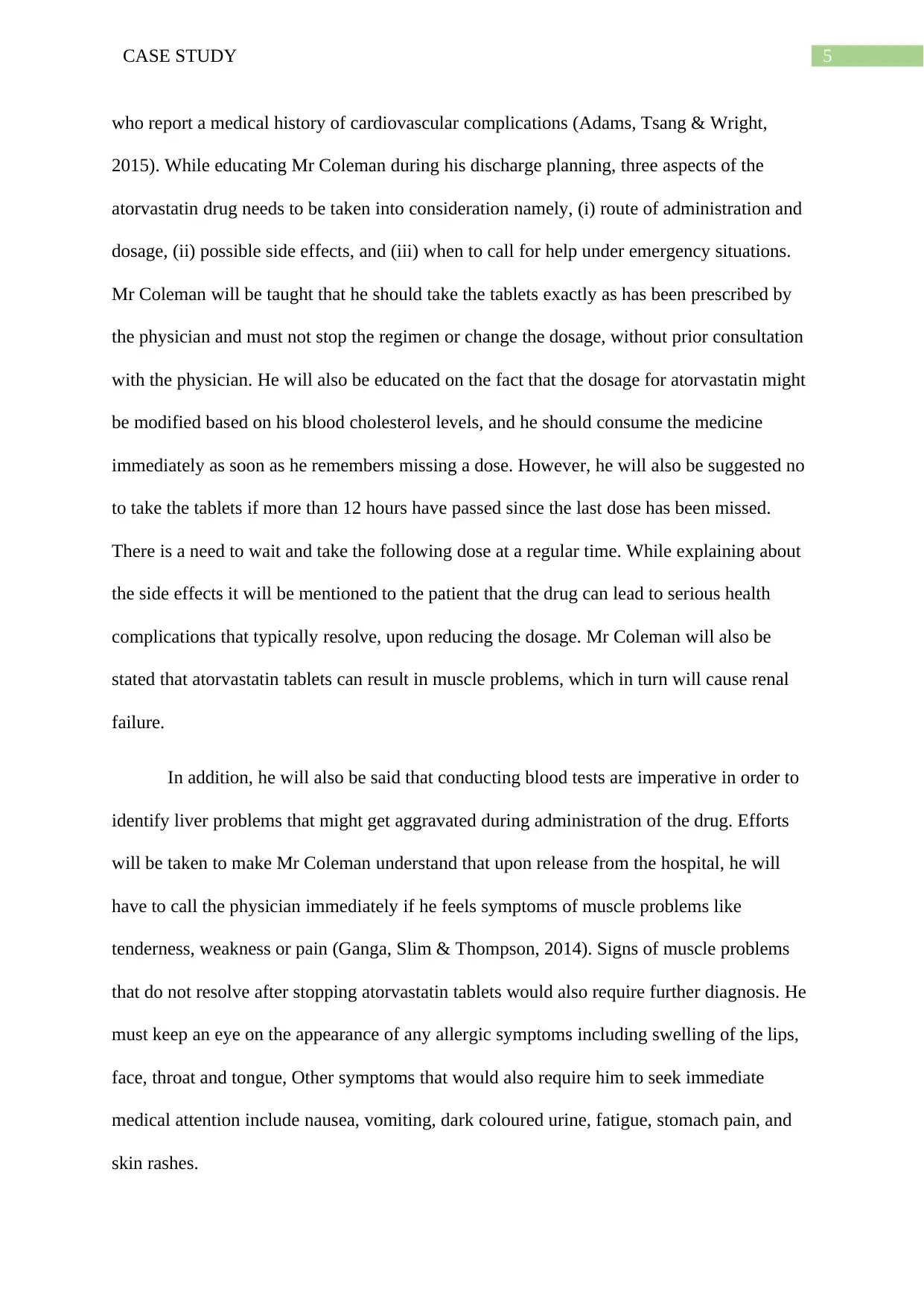
5CASE STUDY
who report a medical history of cardiovascular complications (Adams, Tsang & Wright,
2015). While educating Mr Coleman during his discharge planning, three aspects of the
atorvastatin drug needs to be taken into consideration namely, (i) route of administration and
dosage, (ii) possible side effects, and (iii) when to call for help under emergency situations.
Mr Coleman will be taught that he should take the tablets exactly as has been prescribed by
the physician and must not stop the regimen or change the dosage, without prior consultation
with the physician. He will also be educated on the fact that the dosage for atorvastatin might
be modified based on his blood cholesterol levels, and he should consume the medicine
immediately as soon as he remembers missing a dose. However, he will also be suggested no
to take the tablets if more than 12 hours have passed since the last dose has been missed.
There is a need to wait and take the following dose at a regular time. While explaining about
the side effects it will be mentioned to the patient that the drug can lead to serious health
complications that typically resolve, upon reducing the dosage. Mr Coleman will also be
stated that atorvastatin tablets can result in muscle problems, which in turn will cause renal
failure.
In addition, he will also be said that conducting blood tests are imperative in order to
identify liver problems that might get aggravated during administration of the drug. Efforts
will be taken to make Mr Coleman understand that upon release from the hospital, he will
have to call the physician immediately if he feels symptoms of muscle problems like
tenderness, weakness or pain (Ganga, Slim & Thompson, 2014). Signs of muscle problems
that do not resolve after stopping atorvastatin tablets would also require further diagnosis. He
must keep an eye on the appearance of any allergic symptoms including swelling of the lips,
face, throat and tongue, Other symptoms that would also require him to seek immediate
medical attention include nausea, vomiting, dark coloured urine, fatigue, stomach pain, and
skin rashes.
who report a medical history of cardiovascular complications (Adams, Tsang & Wright,
2015). While educating Mr Coleman during his discharge planning, three aspects of the
atorvastatin drug needs to be taken into consideration namely, (i) route of administration and
dosage, (ii) possible side effects, and (iii) when to call for help under emergency situations.
Mr Coleman will be taught that he should take the tablets exactly as has been prescribed by
the physician and must not stop the regimen or change the dosage, without prior consultation
with the physician. He will also be educated on the fact that the dosage for atorvastatin might
be modified based on his blood cholesterol levels, and he should consume the medicine
immediately as soon as he remembers missing a dose. However, he will also be suggested no
to take the tablets if more than 12 hours have passed since the last dose has been missed.
There is a need to wait and take the following dose at a regular time. While explaining about
the side effects it will be mentioned to the patient that the drug can lead to serious health
complications that typically resolve, upon reducing the dosage. Mr Coleman will also be
stated that atorvastatin tablets can result in muscle problems, which in turn will cause renal
failure.
In addition, he will also be said that conducting blood tests are imperative in order to
identify liver problems that might get aggravated during administration of the drug. Efforts
will be taken to make Mr Coleman understand that upon release from the hospital, he will
have to call the physician immediately if he feels symptoms of muscle problems like
tenderness, weakness or pain (Ganga, Slim & Thompson, 2014). Signs of muscle problems
that do not resolve after stopping atorvastatin tablets would also require further diagnosis. He
must keep an eye on the appearance of any allergic symptoms including swelling of the lips,
face, throat and tongue, Other symptoms that would also require him to seek immediate
medical attention include nausea, vomiting, dark coloured urine, fatigue, stomach pain, and
skin rashes.
⊘ This is a preview!⊘
Do you want full access?
Subscribe today to unlock all pages.

Trusted by 1+ million students worldwide

6CASE STUDY
Paraphrase This Document
Need a fresh take? Get an instant paraphrase of this document with our AI Paraphraser
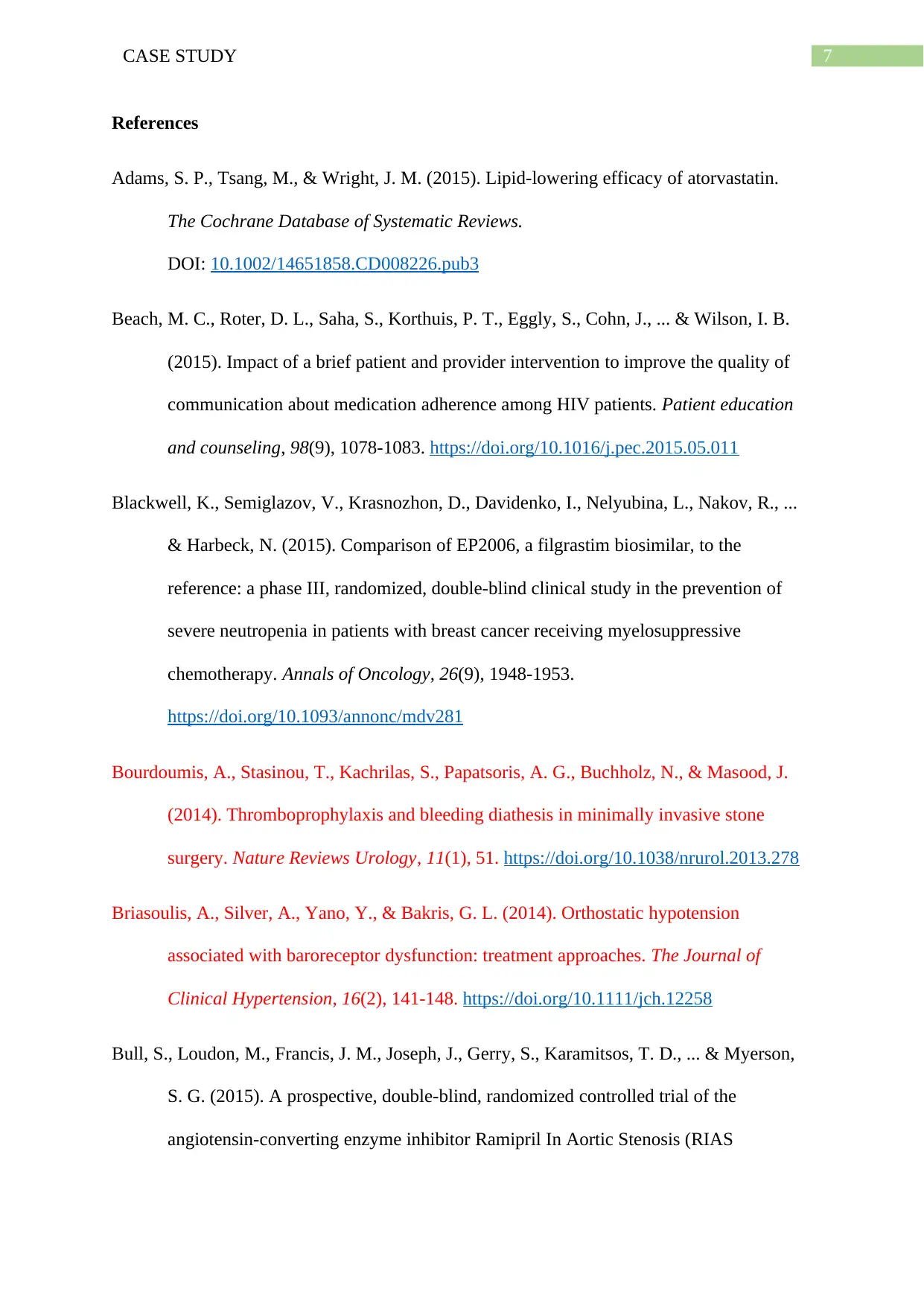
7CASE STUDY
References
Adams, S. P., Tsang, M., & Wright, J. M. (2015). Lipid-lowering efficacy of atorvastatin.
The Cochrane Database of Systematic Reviews.
DOI: 10.1002/14651858.CD008226.pub3
Beach, M. C., Roter, D. L., Saha, S., Korthuis, P. T., Eggly, S., Cohn, J., ... & Wilson, I. B.
(2015). Impact of a brief patient and provider intervention to improve the quality of
communication about medication adherence among HIV patients. Patient education
and counseling, 98(9), 1078-1083. https://doi.org/10.1016/j.pec.2015.05.011
Blackwell, K., Semiglazov, V., Krasnozhon, D., Davidenko, I., Nelyubina, L., Nakov, R., ...
& Harbeck, N. (2015). Comparison of EP2006, a filgrastim biosimilar, to the
reference: a phase III, randomized, double-blind clinical study in the prevention of
severe neutropenia in patients with breast cancer receiving myelosuppressive
chemotherapy. Annals of Oncology, 26(9), 1948-1953.
https://doi.org/10.1093/annonc/mdv281
Bourdoumis, A., Stasinou, T., Kachrilas, S., Papatsoris, A. G., Buchholz, N., & Masood, J.
(2014). Thromboprophylaxis and bleeding diathesis in minimally invasive stone
surgery. Nature Reviews Urology, 11(1), 51. https://doi.org/10.1038/nrurol.2013.278
Briasoulis, A., Silver, A., Yano, Y., & Bakris, G. L. (2014). Orthostatic hypotension
associated with baroreceptor dysfunction: treatment approaches. The Journal of
Clinical Hypertension, 16(2), 141-148. https://doi.org/10.1111/jch.12258
Bull, S., Loudon, M., Francis, J. M., Joseph, J., Gerry, S., Karamitsos, T. D., ... & Myerson,
S. G. (2015). A prospective, double-blind, randomized controlled trial of the
angiotensin-converting enzyme inhibitor Ramipril In Aortic Stenosis (RIAS
References
Adams, S. P., Tsang, M., & Wright, J. M. (2015). Lipid-lowering efficacy of atorvastatin.
The Cochrane Database of Systematic Reviews.
DOI: 10.1002/14651858.CD008226.pub3
Beach, M. C., Roter, D. L., Saha, S., Korthuis, P. T., Eggly, S., Cohn, J., ... & Wilson, I. B.
(2015). Impact of a brief patient and provider intervention to improve the quality of
communication about medication adherence among HIV patients. Patient education
and counseling, 98(9), 1078-1083. https://doi.org/10.1016/j.pec.2015.05.011
Blackwell, K., Semiglazov, V., Krasnozhon, D., Davidenko, I., Nelyubina, L., Nakov, R., ...
& Harbeck, N. (2015). Comparison of EP2006, a filgrastim biosimilar, to the
reference: a phase III, randomized, double-blind clinical study in the prevention of
severe neutropenia in patients with breast cancer receiving myelosuppressive
chemotherapy. Annals of Oncology, 26(9), 1948-1953.
https://doi.org/10.1093/annonc/mdv281
Bourdoumis, A., Stasinou, T., Kachrilas, S., Papatsoris, A. G., Buchholz, N., & Masood, J.
(2014). Thromboprophylaxis and bleeding diathesis in minimally invasive stone
surgery. Nature Reviews Urology, 11(1), 51. https://doi.org/10.1038/nrurol.2013.278
Briasoulis, A., Silver, A., Yano, Y., & Bakris, G. L. (2014). Orthostatic hypotension
associated with baroreceptor dysfunction: treatment approaches. The Journal of
Clinical Hypertension, 16(2), 141-148. https://doi.org/10.1111/jch.12258
Bull, S., Loudon, M., Francis, J. M., Joseph, J., Gerry, S., Karamitsos, T. D., ... & Myerson,
S. G. (2015). A prospective, double-blind, randomized controlled trial of the
angiotensin-converting enzyme inhibitor Ramipril In Aortic Stenosis (RIAS
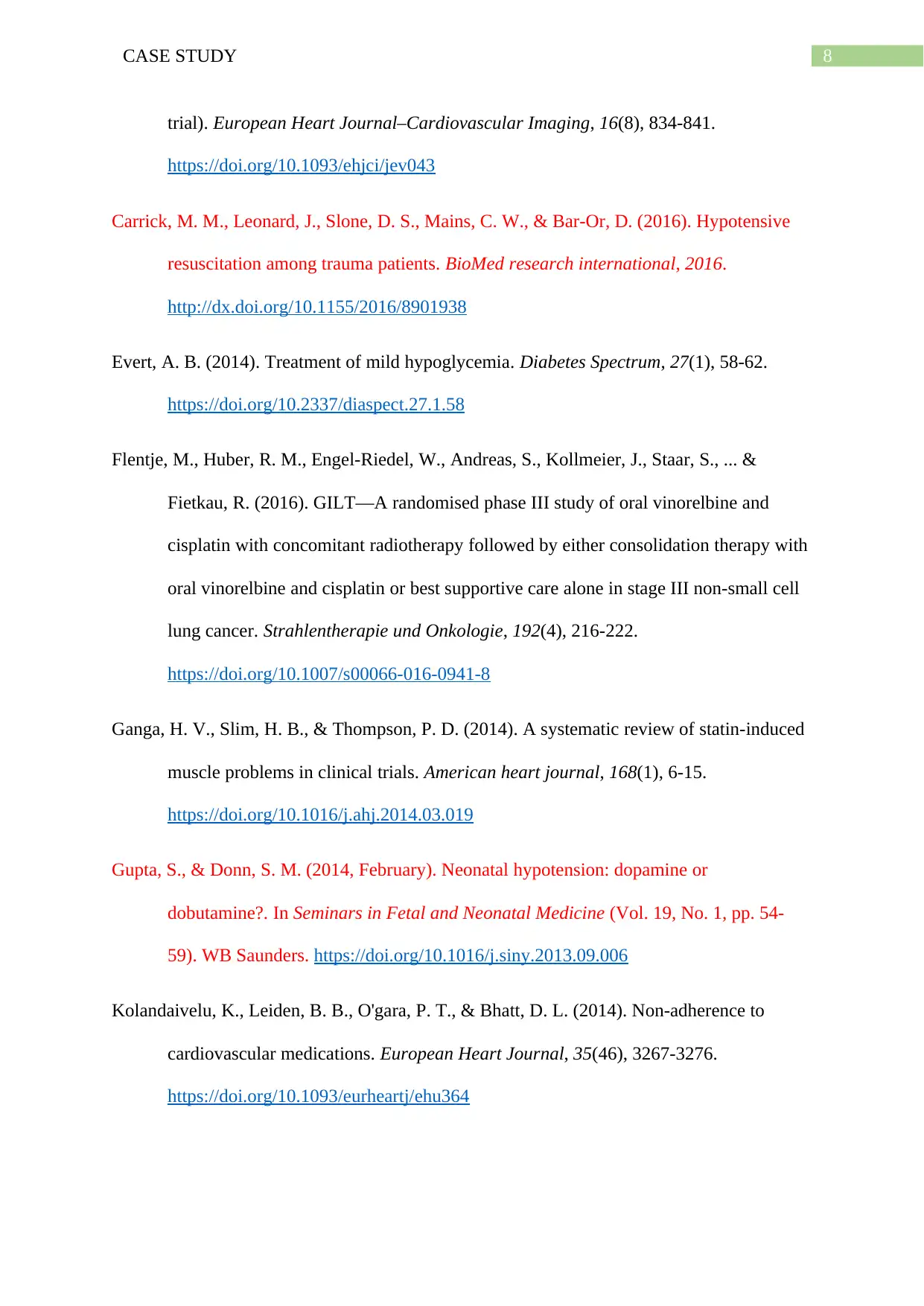
8CASE STUDY
trial). European Heart Journal–Cardiovascular Imaging, 16(8), 834-841.
https://doi.org/10.1093/ehjci/jev043
Carrick, M. M., Leonard, J., Slone, D. S., Mains, C. W., & Bar-Or, D. (2016). Hypotensive
resuscitation among trauma patients. BioMed research international, 2016.
http://dx.doi.org/10.1155/2016/8901938
Evert, A. B. (2014). Treatment of mild hypoglycemia. Diabetes Spectrum, 27(1), 58-62.
https://doi.org/10.2337/diaspect.27.1.58
Flentje, M., Huber, R. M., Engel-Riedel, W., Andreas, S., Kollmeier, J., Staar, S., ... &
Fietkau, R. (2016). GILT—A randomised phase III study of oral vinorelbine and
cisplatin with concomitant radiotherapy followed by either consolidation therapy with
oral vinorelbine and cisplatin or best supportive care alone in stage III non-small cell
lung cancer. Strahlentherapie und Onkologie, 192(4), 216-222.
https://doi.org/10.1007/s00066-016-0941-8
Ganga, H. V., Slim, H. B., & Thompson, P. D. (2014). A systematic review of statin-induced
muscle problems in clinical trials. American heart journal, 168(1), 6-15.
https://doi.org/10.1016/j.ahj.2014.03.019
Gupta, S., & Donn, S. M. (2014, February). Neonatal hypotension: dopamine or
dobutamine?. In Seminars in Fetal and Neonatal Medicine (Vol. 19, No. 1, pp. 54-
59). WB Saunders. https://doi.org/10.1016/j.siny.2013.09.006
Kolandaivelu, K., Leiden, B. B., O'gara, P. T., & Bhatt, D. L. (2014). Non-adherence to
cardiovascular medications. European Heart Journal, 35(46), 3267-3276.
https://doi.org/10.1093/eurheartj/ehu364
trial). European Heart Journal–Cardiovascular Imaging, 16(8), 834-841.
https://doi.org/10.1093/ehjci/jev043
Carrick, M. M., Leonard, J., Slone, D. S., Mains, C. W., & Bar-Or, D. (2016). Hypotensive
resuscitation among trauma patients. BioMed research international, 2016.
http://dx.doi.org/10.1155/2016/8901938
Evert, A. B. (2014). Treatment of mild hypoglycemia. Diabetes Spectrum, 27(1), 58-62.
https://doi.org/10.2337/diaspect.27.1.58
Flentje, M., Huber, R. M., Engel-Riedel, W., Andreas, S., Kollmeier, J., Staar, S., ... &
Fietkau, R. (2016). GILT—A randomised phase III study of oral vinorelbine and
cisplatin with concomitant radiotherapy followed by either consolidation therapy with
oral vinorelbine and cisplatin or best supportive care alone in stage III non-small cell
lung cancer. Strahlentherapie und Onkologie, 192(4), 216-222.
https://doi.org/10.1007/s00066-016-0941-8
Ganga, H. V., Slim, H. B., & Thompson, P. D. (2014). A systematic review of statin-induced
muscle problems in clinical trials. American heart journal, 168(1), 6-15.
https://doi.org/10.1016/j.ahj.2014.03.019
Gupta, S., & Donn, S. M. (2014, February). Neonatal hypotension: dopamine or
dobutamine?. In Seminars in Fetal and Neonatal Medicine (Vol. 19, No. 1, pp. 54-
59). WB Saunders. https://doi.org/10.1016/j.siny.2013.09.006
Kolandaivelu, K., Leiden, B. B., O'gara, P. T., & Bhatt, D. L. (2014). Non-adherence to
cardiovascular medications. European Heart Journal, 35(46), 3267-3276.
https://doi.org/10.1093/eurheartj/ehu364
⊘ This is a preview!⊘
Do you want full access?
Subscribe today to unlock all pages.

Trusted by 1+ million students worldwide
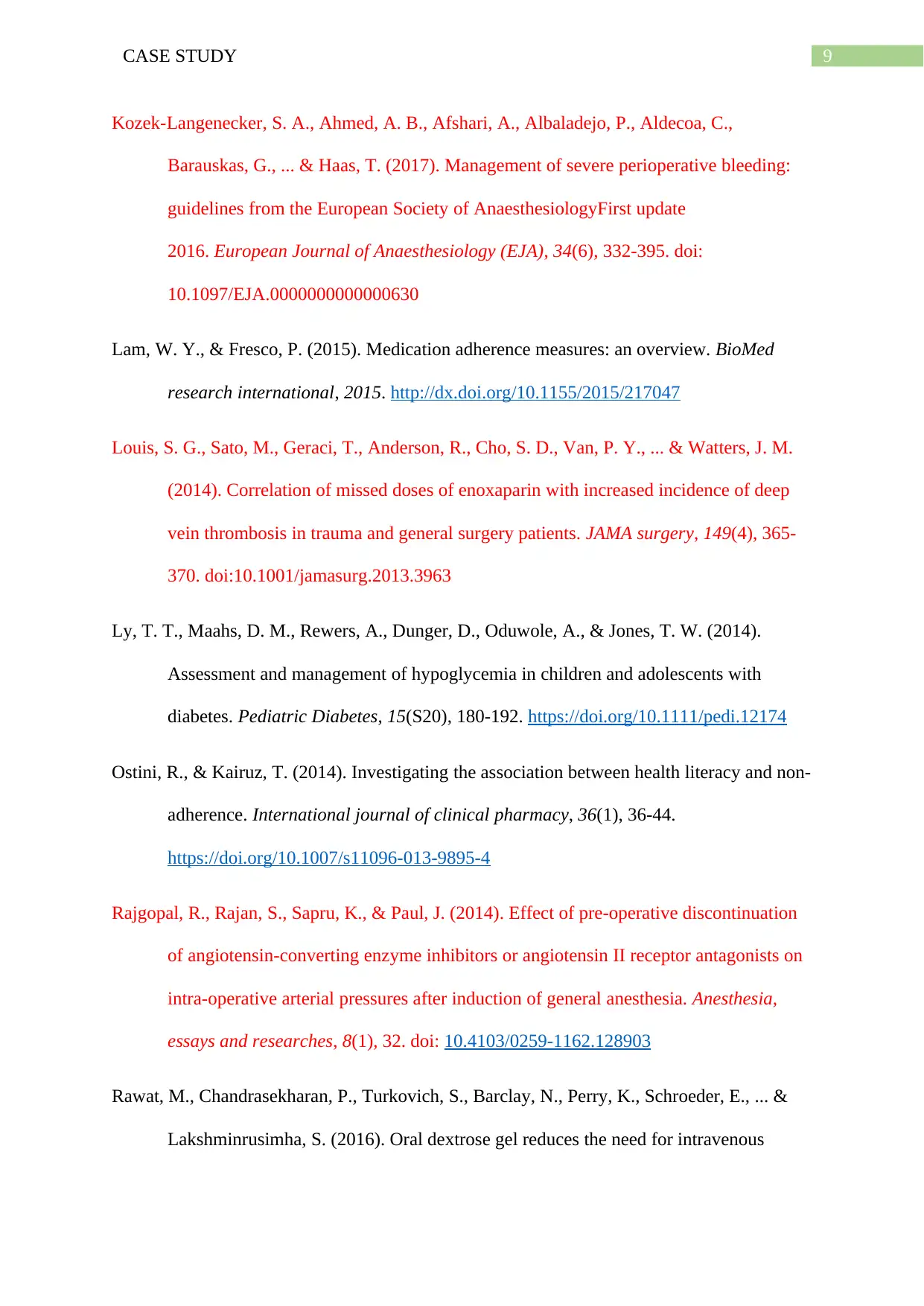
9CASE STUDY
Kozek-Langenecker, S. A., Ahmed, A. B., Afshari, A., Albaladejo, P., Aldecoa, C.,
Barauskas, G., ... & Haas, T. (2017). Management of severe perioperative bleeding:
guidelines from the European Society of AnaesthesiologyFirst update
2016. European Journal of Anaesthesiology (EJA), 34(6), 332-395. doi:
10.1097/EJA.0000000000000630
Lam, W. Y., & Fresco, P. (2015). Medication adherence measures: an overview. BioMed
research international, 2015. http://dx.doi.org/10.1155/2015/217047
Louis, S. G., Sato, M., Geraci, T., Anderson, R., Cho, S. D., Van, P. Y., ... & Watters, J. M.
(2014). Correlation of missed doses of enoxaparin with increased incidence of deep
vein thrombosis in trauma and general surgery patients. JAMA surgery, 149(4), 365-
370. doi:10.1001/jamasurg.2013.3963
Ly, T. T., Maahs, D. M., Rewers, A., Dunger, D., Oduwole, A., & Jones, T. W. (2014).
Assessment and management of hypoglycemia in children and adolescents with
diabetes. Pediatric Diabetes, 15(S20), 180-192. https://doi.org/10.1111/pedi.12174
Ostini, R., & Kairuz, T. (2014). Investigating the association between health literacy and non-
adherence. International journal of clinical pharmacy, 36(1), 36-44.
https://doi.org/10.1007/s11096-013-9895-4
Rajgopal, R., Rajan, S., Sapru, K., & Paul, J. (2014). Effect of pre-operative discontinuation
of angiotensin-converting enzyme inhibitors or angiotensin II receptor antagonists on
intra-operative arterial pressures after induction of general anesthesia. Anesthesia,
essays and researches, 8(1), 32. doi: 10.4103/0259-1162.128903
Rawat, M., Chandrasekharan, P., Turkovich, S., Barclay, N., Perry, K., Schroeder, E., ... &
Lakshminrusimha, S. (2016). Oral dextrose gel reduces the need for intravenous
Kozek-Langenecker, S. A., Ahmed, A. B., Afshari, A., Albaladejo, P., Aldecoa, C.,
Barauskas, G., ... & Haas, T. (2017). Management of severe perioperative bleeding:
guidelines from the European Society of AnaesthesiologyFirst update
2016. European Journal of Anaesthesiology (EJA), 34(6), 332-395. doi:
10.1097/EJA.0000000000000630
Lam, W. Y., & Fresco, P. (2015). Medication adherence measures: an overview. BioMed
research international, 2015. http://dx.doi.org/10.1155/2015/217047
Louis, S. G., Sato, M., Geraci, T., Anderson, R., Cho, S. D., Van, P. Y., ... & Watters, J. M.
(2014). Correlation of missed doses of enoxaparin with increased incidence of deep
vein thrombosis in trauma and general surgery patients. JAMA surgery, 149(4), 365-
370. doi:10.1001/jamasurg.2013.3963
Ly, T. T., Maahs, D. M., Rewers, A., Dunger, D., Oduwole, A., & Jones, T. W. (2014).
Assessment and management of hypoglycemia in children and adolescents with
diabetes. Pediatric Diabetes, 15(S20), 180-192. https://doi.org/10.1111/pedi.12174
Ostini, R., & Kairuz, T. (2014). Investigating the association between health literacy and non-
adherence. International journal of clinical pharmacy, 36(1), 36-44.
https://doi.org/10.1007/s11096-013-9895-4
Rajgopal, R., Rajan, S., Sapru, K., & Paul, J. (2014). Effect of pre-operative discontinuation
of angiotensin-converting enzyme inhibitors or angiotensin II receptor antagonists on
intra-operative arterial pressures after induction of general anesthesia. Anesthesia,
essays and researches, 8(1), 32. doi: 10.4103/0259-1162.128903
Rawat, M., Chandrasekharan, P., Turkovich, S., Barclay, N., Perry, K., Schroeder, E., ... &
Lakshminrusimha, S. (2016). Oral dextrose gel reduces the need for intravenous
Paraphrase This Document
Need a fresh take? Get an instant paraphrase of this document with our AI Paraphraser
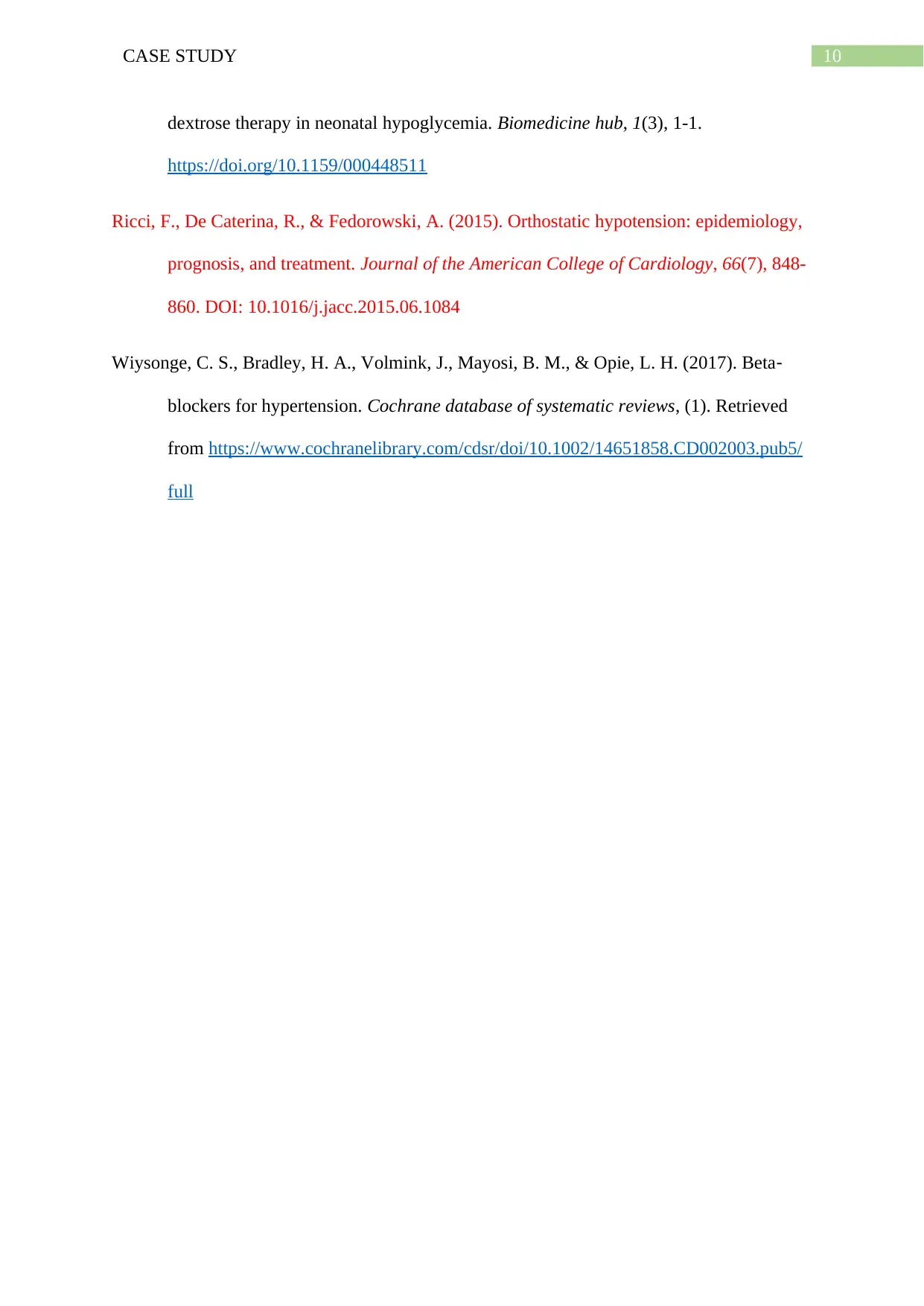
10CASE STUDY
dextrose therapy in neonatal hypoglycemia. Biomedicine hub, 1(3), 1-1.
https://doi.org/10.1159/000448511
Ricci, F., De Caterina, R., & Fedorowski, A. (2015). Orthostatic hypotension: epidemiology,
prognosis, and treatment. Journal of the American College of Cardiology, 66(7), 848-
860. DOI: 10.1016/j.jacc.2015.06.1084
Wiysonge, C. S., Bradley, H. A., Volmink, J., Mayosi, B. M., & Opie, L. H. (2017). Beta‐
blockers for hypertension. Cochrane database of systematic reviews, (1). Retrieved
from https://www.cochranelibrary.com/cdsr/doi/10.1002/14651858.CD002003.pub5/
full
dextrose therapy in neonatal hypoglycemia. Biomedicine hub, 1(3), 1-1.
https://doi.org/10.1159/000448511
Ricci, F., De Caterina, R., & Fedorowski, A. (2015). Orthostatic hypotension: epidemiology,
prognosis, and treatment. Journal of the American College of Cardiology, 66(7), 848-
860. DOI: 10.1016/j.jacc.2015.06.1084
Wiysonge, C. S., Bradley, H. A., Volmink, J., Mayosi, B. M., & Opie, L. H. (2017). Beta‐
blockers for hypertension. Cochrane database of systematic reviews, (1). Retrieved
from https://www.cochranelibrary.com/cdsr/doi/10.1002/14651858.CD002003.pub5/
full
1 out of 11
Related Documents
Your All-in-One AI-Powered Toolkit for Academic Success.
+13062052269
info@desklib.com
Available 24*7 on WhatsApp / Email
![[object Object]](/_next/static/media/star-bottom.7253800d.svg)
Unlock your academic potential
Copyright © 2020–2025 A2Z Services. All Rights Reserved. Developed and managed by ZUCOL.





